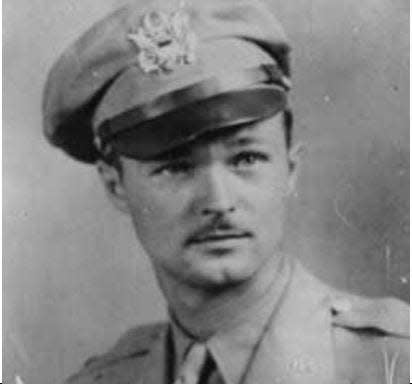Veterans column: WWII veteran Frederick Wright among prisoners in 100-mile death march
- Oops!Something went wrong.Please try again later.

In January 1945, as the Allied forces approached Germany from the west and the Russian army moved in from the east, the Germans decided that they would evacuate the prisons to delay the prisoners' liberation.
According to the article The March (1945) on Wikipedia.org, the German authorities began a series of movements from the various camps towards Poland and Czechoslovakia, and Germany during the first four months of 1942. “This series of events has been called various names: 'The Great March West,' 'The Long March,' 'The Long Walk,' 'The Long Trek,' 'The Black March,' 'The Bread March' and 'Death March Across Germany,' but most survivors just called it 'The March.'“
The occupants of Stalag Luft III, which included 2nd Lt. Frederick Wright was also on the list of men to be moved. After the war, Wright told his daughter, Gill, “that he was far better off in the care of the Germans than under the command of the Russians, who were — in his words — 'ruthless.’” Nevertheless, the Germans initiated these “forced marches.” Navigator and crew mate Robert Ferrell, who was captured with Frederick, called the march the “100-mile death march.” When the orders were given for the prisoners to leave Stalag III, it couldn’t have come at a worse time. The men were already suffering from malnutrition and had very little clothing. They were forced to begin their trek in the coldest January and February Europe had ever seen in the 20th century. Blizzards and temperatures that were well below 0 degrees Celsius, made the conditions unbearable. For Frederick, weighing just 110 pounds, the trip seemed nigh impossible. His family knew little of his suffering until a letter arrived after Frederick's death in 1999.
Veterans column: Frederick Wright's life as a prisoner of war during World War II
His widow had written to Robert Ferrell and asked for any information that he could give about Frederick's war experience, and he had plenty.
Ferrell wrote: “As the last member of the crew to see your late husband be left by the wayside, with Lt. Col. James Parker as an escort, in the knee-deep snow on the forced march from Sagan, Poland (old Poland) to Spremberg, Germany to Moscou, Germany, I remember the situation like it was only yesterday. … If there was anyone (other than the 2nd navigator (Miller) who was hit on the head by FLAK); Fred suffered the worst, being left behind in the snow and freezing temperature with little clothing and having lost about 50 lbs. in weight … and being malnourished. Fred was one of five left behind, with Lt. Col. Parker as escort, to face the onrushing Soviet Armies that broke through at Warsaw, Poland, and were right behind us.”
Frederick was in such bad shape that Ferrell thought that he had died after he left him.
Exactly what happened was never fully disclosed to the family. The unsubstantiated tale is that Frederick made his way via an Allied underground network into Italy. Somehow he made it to safety, and once in the hands of American troops, he was hospitalized. He returned to the United States, eventually ending up in Indiana. His father wrote him a letter on June 22, 1945, which is the first indication of his return to the States. It was typed on the back of a First National Bank deposit slip: “Dear Freddy, welcome home! Let me be the first to tell you how relieved and how delighted we all are to have you safe home again in our midst.”
Veterans column: 2nd Lt. Frederick Wright becomes a prisoner of war during World War II
Fredericks's unit was scheduled to go to the Pacific Theater to fight against the Japanese. On Sept. 2, 1945, the Japanese surrendered, signaling the end of World War II. Many men were discharged and went home; however, Frederick decided to stay in the service, but first, he had some unfinished business in Ohio to which he needed to attend.
Doug Stout is the Local History Coordinator for the Licking County Library. You may contact him at 740-349-5571 ordstout@lickingcountylibrary.org. His book "Never Forgotten: The Stories of Licking County Veterans" is available forpurchase at the library or online at bookbaby.com & Amazon.com.
This article originally appeared on Newark Advocate: Veterans column: Frederick Wright and the 100-mile death march
